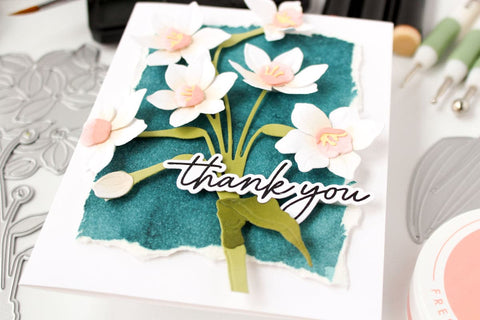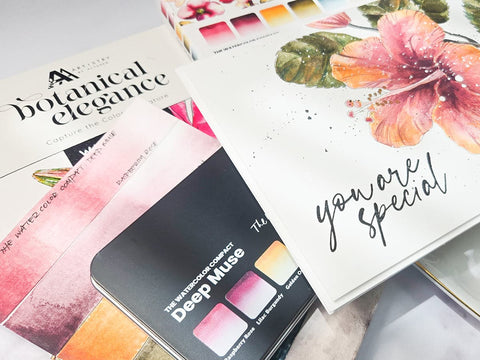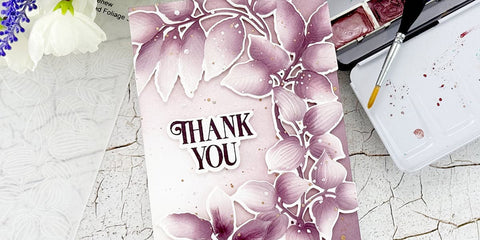12 Watercolor Techniques You Must Try (Beginner-Friendly!)
Last Updated: October 24, 2025
Watercolor painting is a fun and relaxing hobby that anyone can enjoy. And, with so many different watercolor techniques to try, you can easily find a style that suits you. In this blog post, we'll explore 12 watercolor ideas and techniques for card making that you have to try. From watercolor washes and gradients to color blending, there's something here for everyone. So grab your paintbrush and your fave watercolor set, and let's get started!

What are watercolor washes, gradients, and color blending?
Watercolor washes are one of the simplest watercolor techniques. These involve applying a light layer of color to your paper and then letting it dry. This technique can be used to create soft, muted colors or to add depth to your painting.
Gradients are another simple watercolor technique. To create a gradient, simply start with a dark color at the bottom of your painting and gradually lighten the color as you move up the page. This technique can be used to create beautiful skies or sunsets.
Color blending is another great way to create a beautiful watercolor painting. To create a blended color, start with two different colors and mix them on your palette. Then, apply the mixed color to your painting. This technique can be used to create soft, gradient colors or to add depth and interest to your painting.
Card making is a great way to use these fun watercolor techniques. By combining these techniques, you can create beautiful, one-of-a-kind cards that are perfect for any occasion.

Read: How-to Video: Messy Watercolor Card
How to Use Watercolors in Card Making
Watercolor is a versatile medium that can be used in various ways to create beautiful handmade cards. These watercolor card ideas will help you add some new life to your DIY cards and open up a world of possibilities for creating more beautiful works of art.
Let’s explore 12 different watercolor techniques that you can use to create stunning cards.

Try This Technique with Watercolor Brush Markers
1. Watercolor Washes. This is one of the most straightforward watercolor techniques, and it involves applying a thin wash of color to your cardstock. You can use a variety of colors for this technique, and it's a great way to add some color to your card front quickly. Watch the video below to see how Erum created a watercolor wash for her card.
How to Create a Watercolor Wash

A watercolor wash is an excellent way to add color and interest to your paintings. Here's how to create one:
- Choose a color that you want to use for your wash.
- Load your brush with paint, then wet the area where you want the wash to go.
- Begin painting in the wet area, using long, smooth strokes.
- Allow the paint to dry completely before adding any other colors.

Recreate This Card with the Artists' Watercolor 24 Pan Set
2. Gradients and Color Blending. This watercolor process involves blending two or more colors together to create a gradient effect. It's a great way to add depth and interest to your cards. For example, in Erum’s watercolor card, she shows a stunning gradient background, while May’s watercolor flower card showcases a bit of color blending.

Watercolor Essential 12 Pan Set
How to Create a Gradient
Creating a gradient with watercolor is a fun way to add depth and interest to your paintings. By using different colors and techniques, you can create beautiful effects that will make your artwork stand out. There are many different ways to create a gradient.
- One way is to start with two colors next to each other on the color wheel. For example, you could use yellow and orange or red and pink. Another way is to choose two complementary colors, such as blue and orange or purple and yellow.
- Once you have chosen your colors, wet your paper with clean water.
- Then, apply one paint color to the top of the paper using a paintbrush.
- Next, apply the second color of paint to the bottom of the paper.
- To blend the two colors, gently tilt the paper from side to side until you are happy with the results.
If you want to create a more gradual gradient, you can wet the paper first and then apply the paint. Or, you can add more water to one color than the other. Experiment with different watercolor techniques until you find a look that you like. With a little practice, you can create stunning gradients that will impress your friends and family.

Read: Simple Watercolor Flower Card on Colored Cardstock
How to Blend Colors in Watercolor
To create beautiful blends of color in your watercolors, you'll need to use a wet-on-wet technique. This simply means adding water to your paintbrush and your paper before you start adding watercolor pigments. You can either mix the colors on your brush before you start painting or let the colors mix as you go. You can also use a wet-on-dry technique to create blends. This means you use a wet paintbrush to pick up the paint and start painting on your paper (without adding water to it).
Either way, be sure to experiment with different watercolor ideas and colors to see what looks best to you!

Darling Rose Stamp & Die & Mask Stencil Bundle
3. Wet on Wet Technique. This watercolor idea involves painting on wet paper with wet paint. It's a great way to create soft and delicate effects. Watch this watercolor process in Erum’s video below.
4. Dry Brush. This technique involves using a dry brush to paint on your cardstock. It's a great way to add texture and interest to your handmade card.

Garden Delights Stamp & Die Bundle
5. Splatter. This technique involves splattering paint onto your cardstock for a fun and textured effect. This can also be done to add some contrast or interest to a plain white card front. Check out Erum’s fun and easy watercolor splatter card, or try Aga’s subtle addition of splatter to her watercolor flower card.

6. Negative Painting. This technique involves painting around the negative space of a stencil for exciting results. Emily shared this fantastic watercolor idea using negative space for watercoloring light/white flowers.

Read: Faux Free-Hand Watercolor Card
7. Masking. This technique involves using masking fluid to protect certain areas of your card while you paint other areas. It's a great way to achieve interesting results with your watercolors. Lydia’s watercolor card uses a similar masking technique - check it out HERE.

- First, mix water, some dishwashing soap, and 4-5 drops of the Autumn Blaze Liquid Watercolor in the bowl.
- Next, insert the straw into the mix and start blowing into it; this will make the soap bubbles form in the bowl and rise over its rim.
- Then, take a watercolor panel and pick up the bubbles with it. These will “pop” within several seconds, leaving behind an interesting and unique “bubble background”. ‘
- Repeat this watercolor process several times until it covers the whole panel with bubbles.
- After that, dry the panel with a heat tool.
- Next, add another layer of bubbles – doing everything in the same manner and using Crimson Liquid Watercolor this time.
- Let the panel dry completely.

Salt on Watercolor Technique Using Watercolor Brush Markers
9. Salt on Watercolor. This is an oldie-but-goodie watercolor technique that’s definitely a must-try! This simple watercolor idea involves adding salt to a watercolored panel or background. Lydia did a fun experiment and used ground salt and rock salt on two different panels. The one with the ground salt left a much more subtle effect than the one with the chunks of salt (which looked absolutely stunning!). Watch the watercolor process video below to learn this technique.
10. Texture Paste. Texture paste is an excellent medium that can be used with watercolors (and other coloring mediums) for extraordinary results. It is available in various textures, so you can choose the one that best suits your card project. Here’s a fun watercolor idea to try using embossing paste and liquid watercolors.

11. Rainbow Watercolor. One of the best watercolor ideas for card making is creating a lovely rainbow - just like Norine did in this bright and colorful watercolor card. There are many ways to do this, but Norine’s card involves some color blending.

12 . Galaxy Watercolor Background. Another fun watercolor trick to try on your handmade cards is creating a galaxy watercolor background. Watch Erum’s watercolor process video below to learn more about this technique.
These are just a few of the many watercolor techniques you can use to create beautiful DIY cards. Experiment with different watercolor ideas and mediums to see what else you can create! The creative possibilities are truly endless when it comes to this versatile medium.

Read: Freehand Watercoloring with Stencils
Tips for Working with Watercolors
Watercolors can be a little daunting for beginners, but with a few watercolor tricks and tips, you'll be creating beautiful pieces in no time. Here are some tips for working with watercolors:
- Make sure your watercolor paper is heavyweight and preferably acid-free.
- Always test your colors on a piece of scrap paper before starting your masterpiece.
- To create washes, start with a light color and gradually add more layers to darken the color.
- To create gradients, mix two or more colors together and paint in a circular motion.
- Use a wet brush to blend colors together and create soft edges.
- When painting details, use a very dry brush so that the paint doesn't spread out too much.
- For extra sparkle, add some salt to your paint while it's still wet.
- Let your paintings dry completely before framing or adding any finishing touches.
- Watercolors can be used for both traditional and digital artwork - just experiment until you find what works best for you!
- Always keep your paints and brushes well-mixed to avoid clumps or streaks.
- Be patient and take your time while painting - it's better to do it slowly and get it right than to rush through it and make mistakes.
- Most importantly, have fun with watercolors and experiment with different watercolor techniques to see what works best for you!

Read: Acrylic Block Watercolor Backgrounds
Try These Watercolor Ideas for Card Making Today!
Watercolor is a beautiful and versatile medium that can be used to create stunning works of art. From washes and gradients to color blending and rainbow watercolor, there are plenty of watercolor ideas here to get you started with your next watercolor card project. Have you tried any of these techniques? How was it? Let us know in the comments below!
As always, feel free to drop by our All About Crafting page for more watercolor tricks, tips, ideas, and other paper crafting-related reads!
2 comments
In This Article
More Crafty Reads & Inspirations
-

January 2026 Inspiration Challenge
-

Simple Tips To Bring Your Die Cut Florals To Life - A Touch of Sparkle With Carissa Wiley
-

3 Secrets for No-Outline Watercoloring: The Art of the Disappearing Line | Perfect Pairings with Jaycee
-

Card Ideas that Symbolize New Beginnings
-

Transform Your Stenciled Image with a 3D Embossing Folder
















Thank you so much for stopping by, Traci! Glad these projects and techniques inspired you. Hope to see your watercolor project soon. Make sure to tag us when you post it on social media. :)
What a fantastic assortment of techniques! I learned so much! These projects are stunning! Thank you!